Case Study
-
United States -
United Kingdom -
India -
France -
Deutschland -
Italia -
日本 -
대한민국 -
中国 -
台灣
-
Ansysは、シミュレーションエンジニアリングソフトウェアを学生に無償で提供することで、未来を拓く学生たちの助けとなることを目指しています。
-
Ansysは、シミュレーションエンジニアリングソフトウェアを学生に無償で提供することで、未来を拓く学生たちの助けとなることを目指しています。
-
Ansysは、シミュレーションエンジニアリングソフトウェアを学生に無償で提供することで、未来を拓く学生たちの助けとなることを目指しています。
“This research will not be achieved without a well-developed software equipped with required features. With advanced progress in computational technology combined with the remarkable capabilities of Ansys SpaceClaim, Ansys Fluent Mosaic Meshing, Ansys Fluent, and Ansys EnSight, as well as Ansys’ parallel processing capabilities, we can utilize engineering and mathematical knowledge to research art and archeology successfully.”
— Mongkol Kaewbumrung, Ph.D., Assistant Professor, Rajamangala University of Technology Suvarnabhumi
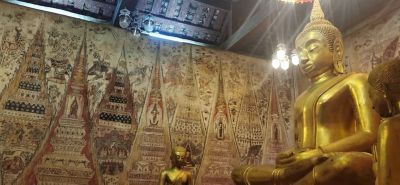
Ancient mural at Wat Ko Kaeo Suttharam in Phetchaburi, Thailand
Home to some of Thailand’s finest art and culture, Ayutthaya was established as one of the region’s greatest cities and flourished between the 14th and 18th centuries. It was declared a United Nations Educational, Scientific, and Cultural Organization (UNESCO) World Heritage Site in 1991.
Murals were popular in the ancient Thai royal palace, but sadly, much of Ayutthaya was destroyed by war in 1767. For this reason, an assistant professor at Rajamangala University of Technology Suvarnabhumi in Thailand has embarked on a personal mission to prevent the deterioration of remaining murals using Ansys computational fluid dynamics (CFD).
Challenges
Although the organic pigments used in ancient murals can last for long periods of time, an accumulation of humidity can lead to deterioration. In addition, rising climate change, pollution, and urbanization negatively impact air quality and wind outside many historic monasteries, accelerating the deterioration of the murals and artwork inside. Underground moisture also affects the structure of some of the temples.
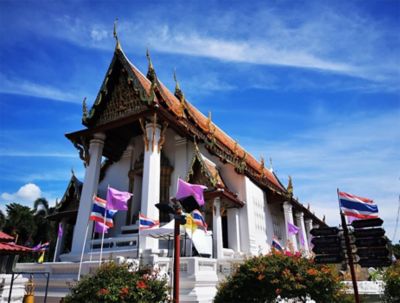
Wat Na Phramen monastery in the historic city of Ayutthaya in Thailand
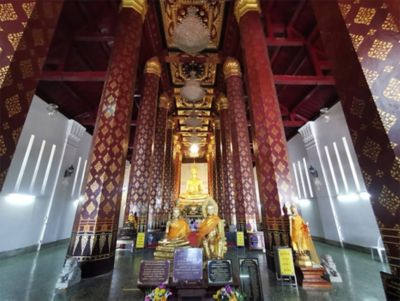
Wat Na Phramen houses an ordination hall and a statue of the Buddha.
Engineering Solutions
To study how environmental conditions impact ancient fine art, Mongkol Kaewbumrung, Ph.D., examined murals at the Wat Na Phramen monastery. He prepared 3D models of art samples using Ansys SpaceClaim and Ansys DesignModeler and constructed mesh in Ansys Fluent Mosaic Meshing. Fluent’s Mosaic Meshing capability enables researchers to transition between varying types of mesh, including polyhedral, hexahedral, and isotropic poly prism elements. The technique reduces the required time for grid creation while maintaining high quality for a transient flow analysis in Ansys Fluent.
Kaewbumrung constructed the grids using more than 12 million units of mesh, including about 5 million polyhedral, 4 million hexahedral, and 3 million isotropic poly prism elements. He leveraged Ansys’ high-performance computing (HPC) and parallel processing capabilities in Fluent and Fluent Mosaic Meshing as well as Ansys EnSight, a data visualization tool that can process models containing hundreds of millions of cells. Boundary conditions for fluidity and humidity distribution were defined using weather data supplied for the central region of Thailand during March and April 2021.
The CFD simulations revealed a large vortex of humidity and temperature in the monastery — an accumulation due to increased climate change, pollution, and urbanization. Kaewbumrung’s research confirms that humidity plays a role in mural deterioration and illustrates an accurate way to detect and monitor it. This offers critical insight into prevention and maintenance techniques. For example, Kaewbumrung will examine organic colors more closely to improve present-day materials after he discovered that they endure better than chemical-based materials.

The ceiling of Wat Na Phramen features ancient wooden mandalas that are lacquered in black and gold.
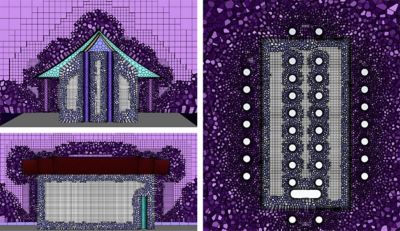
More than 12 million units of mesh were constructed using Ansys Fluent Mosaic Meshing and included a mix of polyhedral, hexahedral, and isotropic poly prism elements.
Benefits
- Ansys CFD analyses help predict the flow and distribution of humidity over time.
- Fluent Mosaic Meshing enables grid diversity, including polyhedral, hexahedral, and isotropic poly prism elements, which reduces creation time while maintaining high accuracy.
- HPC and parallel processing capabilities in Fluent and Fluent Mosaic Meshing expedite CFD simulations.
- EnSight assists with data visualization for CFD models containing hundreds of millions of cells.
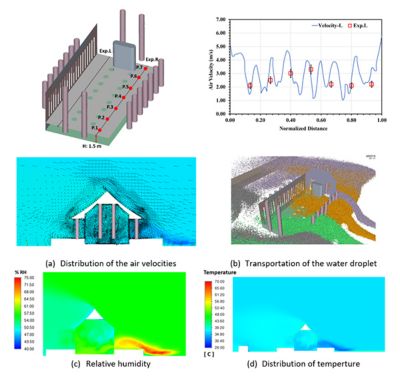
A comparison of Ansys Fluent simulations to actual measurements illustrates high accuracy for the air velocity models.
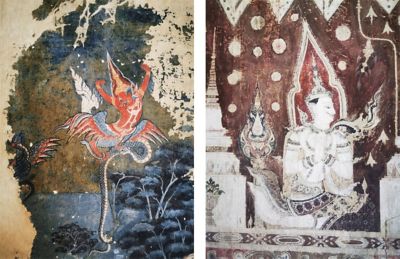
Mural paintings at the temples Wat Chang Yai (left) and Wat Mai Pratu Chumpol (right) in Ayutthaya demonstrate the longevity of ancient organic substances versus chemical colors, which peel off the wall (as seen in the background of the left mural).
Ansysができること
Ansysができること
お問い合わせ
お問い合わせいただき、ありがとうございます。
当社はお客様の質問にお答えし、お客様とお話できることを楽しみにしています。Ansysの営業担当が折り返しご連絡いたします。











